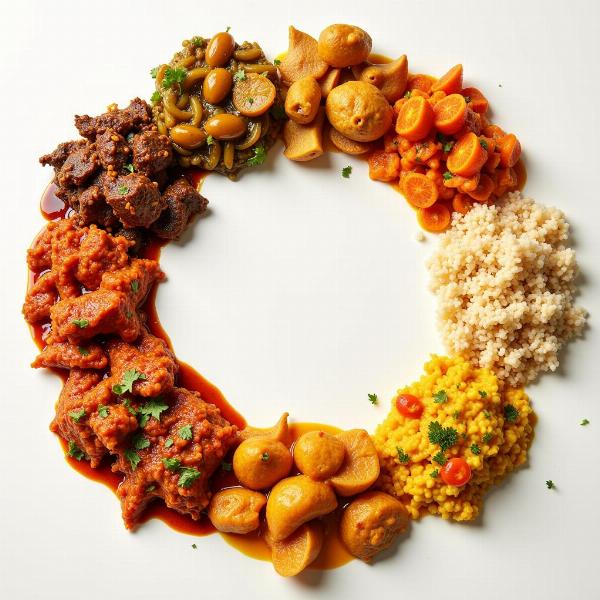Curry, a staple in many Indian kitchens, often evokes images of rich, flavorful dishes. But what exactly does “curry” mean in Hindi? Understanding its meaning goes beyond a simple translation and delves into the heart of Indian cuisine and culture. This article explores the nuances of “curry” in Hindi, its historical context, and its diverse interpretations across the Indian subcontinent.
Decoding “Curry”: More Than Just a Word
While there isn’t one single perfect Hindi equivalent for “curry,” the closest terms are करी (kari) and तरकारी (tarkaari). Kari is a relatively recent addition to the Hindi lexicon, borrowed from the English word “curry.” Tarkaari, on the other hand, is a more traditional term, referring generally to vegetable dishes, often cooked with spices and gravy. So, when someone asks, “what curry meaning in hindi?” the answer isn’t straightforward. It depends on the context and the specific dish being referred to. Are we talking about a South Indian sambar, a North Indian butter chicken, or a simple vegetable stir-fry? Each has its own distinct name in Hindi, reflecting the incredible diversity of Indian cuisine.
 What Curry Means in Hindi
What Curry Means in Hindi
The Evolution of “Curry” in India
The word “curry” has a fascinating history, rooted in colonial interpretations of Indian cooking. British colonizers, encountering a vast array of spiced dishes, simplified things by using the term “curry” as a catch-all. This generalization, while convenient, overlooked the nuanced regional variations and specific dish names that existed in India. Over time, “curry” became integrated into Indian languages, including Hindi, often used alongside or in place of more traditional terms.
Regional Variations: A Curry for Every Palate
India’s culinary landscape is a tapestry of flavors, influenced by geography, climate, and cultural traditions. What constitutes a “curry” varies significantly across the country. In the south, coconut milk and tamarind feature prominently, while in the north, yogurt and cream-based gravies are common. From the spicy vindaloos of Goa to the rich rogan josh of Kashmir, “curry” encompasses a vast spectrum of flavors and textures. This regional diversity adds to the complexity of defining “curry” in Hindi.
Beyond the Basics: Understanding Indian Spices
The heart of any Indian “curry” lies in its spices. Cumin, coriander, turmeric, chili powder, and garam masala are just a few of the common spices that form the foundation of Indian cooking. The specific blend of spices used varies from dish to dish, creating the unique flavor profiles that characterize Indian cuisine. Understanding the role of spices is crucial to understanding what “curry” signifies in the Indian context. Do you want to know more about spices used in Indian cooking? Check out our article on chane meaning in hindi to understand the nuances of chickpea, a common ingredient in Indian cuisine.
Curry in Everyday Life: From Home Kitchens to Restaurants
“Curry” is not just a culinary term; it’s an integral part of Indian culture. From everyday meals to special occasions, “curry” in its various forms graces tables across the country. Whether it’s a simple dal or an elaborate biryani, these dishes reflect the rich heritage of Indian cooking. You might be interested in learning more about other traditional Indian dishes like khichdi meaning in hindi or chhanna meaning in hindi.
Conclusion: A Culinary Journey Through “Curry”
So, “what curry meaning in hindi?” It’s a question with a multifaceted answer. While Kari and Tarkaari serve as translations, the true meaning of “curry” in the Indian context goes beyond a single word. It represents a vibrant tapestry of flavors, traditions, and regional variations, reflecting the rich culinary heritage of India. Understanding “curry” is a journey into the heart of Indian cuisine and culture. Another interesting ingredient to explore is chikana meaning in hindi, which refers to slippery or smooth textures often found in certain curries.
FAQ
-
What is the most common Hindi word for “curry”? While “kari” (करी) is used, “tarkaari” (तरकारी) is a more traditional term for vegetable dishes often considered “curries.”
-
Why are there so many different types of “curry”? India’s diverse regions, climates, and cultures have led to a wide array of curry preparations.
-
Are all Indian “curries” spicy? No, not all Indian curries are spicy. The level of spice varies greatly depending on the dish and regional preferences.
-
What is the difference between “curry” and “tarkaari”? “Curry” is a broader term, while “tarkaari” generally refers to vegetable dishes.
-
Is “curry” an Indian word? No, “curry” is derived from a Tamil word and was popularized by British colonizers.
-
What are some common spices used in Indian “curries”? Cumin, coriander, turmeric, chili powder, and garam masala are frequently used.
-
Where can I learn more about Indian cooking? There are numerous resources available online and in print, including cookbooks and websites dedicated to Indian cuisine.
About Meaning-Hindi.in
Meaning-Hindi.in is your one-stop solution for all your Hindi translation needs. We offer a wide range of services, from business and legal document translation to website localization and technical manual translation. Our team of expert translators ensures accuracy, cultural sensitivity, and timely delivery. Whether you need a quick translation or a complex project, we have the expertise to meet your specific requirements. Contact us today at [email protected] or +91 11-4502-7584 to discuss your translation needs. Let Meaning-Hindi.in bridge the language gap for you!